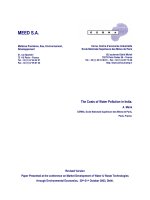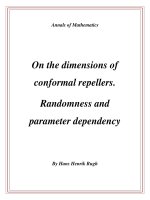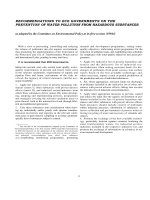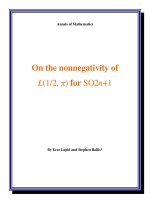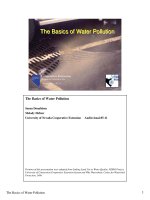WORKSHOP ON THE PREVENTION OF WATER POLLUTION DUE TO PIPELINE ACCIDENTS pot
Bạn đang xem bản rút gọn của tài liệu. Xem và tải ngay bản đầy đủ của tài liệu tại đây (1.19 MB, 30 trang )
ULTNE
WORKSHOP ON THE
PREVENTION OF WATER POLLUTION
DUE TO PIPELINE ACCIDENTS
ULTNE
International standards and recommended practices
for the safety and environmental integrity level of
international oil pipeline systems
Mr. Lars Bangert, Head of Unit "Pipeline Systems",
ILF Consulting Engineers, Germany
Thursday, 9 June 2005
UN
AGENDA
AGENDA
1. Overview and Terminology
2. Functional Design Criteria for the SCADA System
Process requirements
Pipeline integrity requirements
Operational requirements
3. Functional Design Criteria for the Telecom System
Process requirements
Operational requirements
Pipeline integrity requirements
UN
AGENDA
AGENDA
4. Pipeline Integrity
Design and Review of Safety Integrity Level
SCADA built in (internal) control mechanism
operational (external) control mechanism
5. SCADA Design Implementation
6. Telecom Design Implementation
UN
1. Overview and Terminology
1. Overview and Terminology
a) Automation & Control Terminology
SCADA Supervisory Control and Data Acquisition
ICSS Integrated Control and Safety System
DCS Distributed Control System
PLC Programmable Logic Controller
FSC Fail Safe Controller
UN
1. Overview and Terminology
1. Overview and Terminology
b) Purpose of (Pipeline) SCADA systems
Integration of field equipment (e.g. actuator, sensor or pump) and
small scale (unit) automation systems to the control centre computer
system
Transparent view for an operator on a complex process
environment
Efficient management/control of a remote process
Support of pipeline integrity
(for safety, environmental and commercial aspects)
UN
1. Overview and Terminology
1. Overview and Terminology
c) Purpose of (Pipeline) Telecom Systems
data channels for the SCADA system
voice channels for Operator instruction (control centre – local
control room)
Data channels for business WAN application
(e.g. facility management, GIS-data warehouse, e-mail, etc.)
UN
2.
2.
Functional Design Criteria for the SCADA System
Functional Design Criteria for the SCADA System
a) Process requirements
prevent critical process conditions
Pump Station control
(suction-/discharge-pressure control including overrides)
(open) flow path monitoring
slack line control
b) Pipeline Integrity requirements
Integrated control and safety system (e.g. PSHH interlocks)
SCADA built in monitoring mechanism (e.g. LDS, PCM)
Programmed automatic ESD-Sequences
(e.g. ESD-Pushbutton, Shut-Down due to Communication Failure)
UN
2.
2.
Functional Design Criteria for the SCADA System
Functional Design Criteria for the SCADA System
c) Operational requirements
Remote Control via Control Centre
Point-of-control (transfer procedures)
simplified and summarized process information for the Operator
Process Visualisation and Reporting (Process Displays and Alarm
Handling)
Integration of third party equipment
Executive Control Sequences to support operator action
UN
3.
3.
Functional Design Criteria for the
Functional Design Criteria for the
Telecom
Telecom
System
System
a) Process requirements
redundant communication channels for SCADA system
b) Operational requirements
high system availability (Î “no comms, no operation”)
Voice channels for operator communication
Data channels for business applications
Video conference facilities
c) Pipeline Integrity requirements
Reliable communication necessary for critical process data
exchange (Î Back-up communication link via satellite)
Hotline functionality between operator control rooms
UN
4.
4.
Pipeline Integrity
Pipeline Integrity
-
-
Design and Review of
Design and Review of
Safety Integrity Level (SIL)
Safety Integrity Level (SIL)
Plant Area
Gas
OilWater
Well Fluids
ESD Valve
High
Pressure
Sensor
Mechanical
Relief Valve
to Flare
Shutdown System
Logic Solver
Control Room
Operator Interface
Separator
Example for a safety instrumented function
UN
4.
4.
Pipeline Integrity
Pipeline Integrity
-
-
Design and Review of
Design and Review of
Safety Integrity Level (SIL)
Safety Integrity Level (SIL)
Various Reasons for SIL Assessment:
1. How much reliance do we need to place on the protective
system to address the process safety concerns for a given
application?
or
What integrity does it need to have?
What is its required performance standard?
2. Engineer and maintain the system to
- achieve the required integrity or
- performance standard during its life
UN
4.
4.
Pipeline Integrity
Pipeline Integrity
-
-
Design and Review of
Design and Review of
Safety Integrity Level (SIL)
Safety Integrity Level (SIL)
3. national regulatory authorities expect it from us as prudent
operators
4. Allows us to focus testing effort on the minority of safety
systems which are critical for managing safety,
environmental or commercial risks and spend less effort
on the majority which are not critical
UN
4.
4.
Pipeline Integrity
Pipeline Integrity
-
-
Design and Review of
Design and Review of
Safety Integrity Level (SIL)
Safety Integrity Level (SIL)
Four Safety Integrity Levels are defined in IEC 61508 / IEC 61511
NR = Not Recommended
Safety
Integrity
Level (SIL)
4 (NR)
Probability of
Failure on
Demand (PFD)
10
-4
-10
-5
3
2
1
10
-3
-10
-4
10
-2
-10
-3
10
-1
-10
-2
Probability of
Success on
Demand
90 - 99%
99 - 99.9%
99.9 - 99.99%
99.99 - 99.999%
Risk
Reduction
Factor (RRF)
10 - 100
100 - 1,000
10,000 - 100,000
1,000 - 10,000
UN
4.
4.
Pipeline Integrity
Pipeline Integrity
-
-
Design and Review of
Design and Review of
Safety Integrity Level (SIL)
Safety Integrity Level (SIL)
How to determine SIL?
¾ None of the standards recommend a particular qualitative
or (semi-) quantitative method
¾ The standards suggest several methods in informative
guidance as examples only
¾ No standard calibrates any of the suggested methods i.e.
sets a tolerable risk level. This is up to the end user
organizations.
UN
4.
4.
Pipeline Integrity
Pipeline Integrity
-
-
Design and Review of
Design and Review of
Safety Integrity Level (SIL)
Safety Integrity Level (SIL)
Team approach, similar to Hazop
¾ Safety Engineer
¾ Process/Pipeline Engineer
¾ Operations Representative
¾ Instrument/Control Engineer
¾ Bring in other skills as required e.g. machinery
UN
4.
4.
Pipeline Integrity
Pipeline Integrity
-
-
Design and Review of
Design and Review of
Safety Integrity Level (SIL)
Safety Integrity Level (SIL)
Risk Graph from IEC 61508 / 61511
a = No special safety requirements
b = A single E/E/PES is not sufficient
Consequence
Severity
Frequency &
Exposure
Time
Alternatives
To Avoid
Danger
Demand Rate
Very Low
a
1
2
a
1 a
321
432
b 43
Minor Injury
Not Likely
Possible
Serious Injuries
or 1 Death
Death to
several people
Very many
people killed
Rare
Frequent
R
F
Low
Relatively High
Safety Integrity Level (SIL)
-
P
P
P
N L
N L
N L
F
R
UN
4.
4.
Pipeline Integrity
Pipeline Integrity
-
-
Design and Review of
Design and Review of
Safety Integrity Level (SIL)
Safety Integrity Level (SIL)
Environmental Risk Graph adapted from Safety Risk Graph
Very Low
Low
Relatively High
Consequence
Severity –
Environmental
Damage
Alternatives
To Avoid
Damage
Demand Rate
1
2
a
1 a
321
432
b 43
Not Likely
Possible
Environmental Integrity Level (EIL)
-
P
P
P
N L
N L
N L
Ca - minor
Cb – local outrage
Cc – national outrage
Cd – multinational outrage
UN
4.
4.
Pipeline Integrity
Pipeline Integrity
-
-
Design and Review of
Design and Review of
Safety Integrity Level (SIL)
Safety Integrity Level (SIL)
Commercial Risk Graph adapted from Safety Risk Graph
Very Low
Low
Relatively High
Consequence
Severity –
Commercial
Impact
Alternatives
To Avoid
Impact
Demand Rate
a
1
-
a-
21a
321
432
Not Likely
Possible
Commercial Integrity Level (CIL)
-
P
P
P
N L
N L
N L
Ca - $50k - $500k
Cb – >$500k - $5m
Cc – >$5m - $50m
Cd – >$50 million
Calibrated to be risk neutral
UN
4.
4.
Pipeline Integrity
Pipeline Integrity
-
-
Design and Review of
Design and Review of
Safety Integrity Level (SIL)
Safety Integrity Level (SIL)
Required Information for SIL determination
¾ P&IDs
¾ Design information on plant, PSV pressure ratings, pipeline
hydraulic analysis, dynamic response to disturbances
¾ Cause and Effect Diagrams
¾ Setpoints of trips and margin from alarm levels
UN
4.
4.
Pipeline Integrity
Pipeline Integrity
-
-
Design and Review of
Design and Review of
Safety Integrity Level (SIL)
Safety Integrity Level (SIL)
Required Information for SIL determination
¾ Hazop reports
¾ QRAs – assumptions on event sizes and frequencies
¾ Personnel distribution and occupancy at the sites
¾ Proximity of the public to the sites
¾ Environmental impacts of loss of containment
¾ Value of partial and full pipeline shutdown per day
UN
4.
4.
Pipeline Integrity
Pipeline Integrity
-
-
special SCADA applications to
special SCADA applications to
monitor Pipeline Integrity
monitor Pipeline Integrity
a) Leak Detection System (LDS)
Conventional Detection and Location Methods
Mass Balance
Pressure Drop
(negative) pressure wave
Dynamic Model of the pipeline system
b) Pressure Cycle Monitoring System (PCM-System)
Calculation of the remaining Pipeline system lifetime, based on
monitored and classified pressure cycles
UN
4. Pipeline Integrity
4. Pipeline Integrity
-
-
operational control mechanism
operational control mechanism
a) Intelligent pig runs
Monitoring of internal pipe corrosion
Detection of very small leakage
b) Flight
surveys
Monitoring of activities across the Pipeline Right-of-
Way(e.g. construction work, erosion, any changes)
UN
5. SCADA Design Implementation (Typical System Architecture)
5. SCADA Design Implementation (Typical System Architecture)
UN
5. SCADA Design Implementation (Key Data)
5. SCADA Design Implementation (Key Data)

